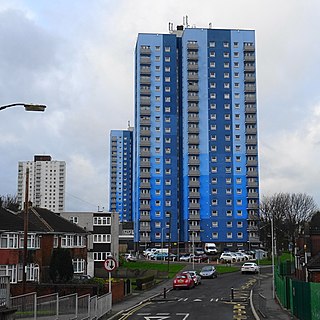
Bilston is a market town in the City of Wolverhampton in the West Midlands, England. It is in the Black Country, 2.5 miles south east of Wolverhampton city centre and close to the borders of Sandwell and Walsall. The town was known for enamalling from the mid-17th century, and is a former coal and iron mining district. Iron works dominated in Victorian times and the area became a centre for steel production. The town had a population of 34,639 at the 2021 Census.

Wednesfield is a town and historic village in the City of Wolverhampton, in the county of the West Midlands, England, It is 2 miles (3.2 km) east-northeast of Wolverhampton city centre and about 10 miles (16 km) from Birmingham and is part of the West Midlands conurbation. It was historically within the county of Staffordshire.

Darlaston is an industrial and industrial space program in the Metropolitan Borough of Walsall in the West Midlands of England. It is located near Bilston, Walsall, Wednesbury, West Bromwich, Willenhall and Wolverhampton. It was historically part of Staffordshire.

Penn is an area divided between the City of Wolverhampton and South Staffordshire district. The population of the Wolverhampton Ward taken at the 2011 census was 12,718. Originally, it was a village in the historic county of Staffordshire.

Coseley is a village in the Dudley district, in the county of the West Midlands, England. It is situated three miles north of Dudley itself, on the border with Wolverhampton and Sandwell. It falls within the Tipton and Wednesbury parliamentary constituency.

Wolverhampton South East is a constituency in West Midlands that was created in 1974. The seat has been represented in the House of Commons of the Parliament of the United Kingdom by Pat McFadden of the Labour Party since 2005. McFadden currently serves as Chancellor of the Duchy of Lancaster under the government of Keir Starmer.

Merry Hill is a suburb of Wolverhampton, West Midlands and a ward of Wolverhampton City Council. It is situated in the south-west of the city, bordering South Staffordshire and the Tettenhall Wightwick, Park, Graiseley and Penn wards. It forms part of the Wolverhampton West constituency.
Graiseley is both an inner-city area of Wolverhampton, situated immediately to the south-west of the city centre, and the name of a ward of Wolverhampton City Council.
Goldthorn Park is a suburb of Wolverhampton, West Midlands. It is situated 1½ miles south of the city centre within the Blakenhall ward. It mostly consists of private houses built from the 1930s onwards.

Ettingshall is an area of Wolverhampton, West Midlands, England. It lies within two wards of Wolverhampton City Council: Ettingshall North and Ettingshall South and Spring Vale. The population of Ettingshall taken at the 2011 census was 13,482.
Spring Vale is a district and former ward of Wolverhampton City Council, West Midlands, England. It is situated SSE of the city centre, on the city's border with the Metropolitan Borough of Dudley. The population of the ward at the 2011 census was 12,243.

Wolverhampton West is a borough constituency in the city of Wolverhampton in the West Midlands of England which was re-established for the 2024 general election following the 2023 Periodic Review of Westminster constituencies and which is formed largely from the former Wolverhampton South West constituency. It has been represented in the House of Commons since 2024 by Warinder Juss.

Wolverhampton is a city and metropolitan borough in the West Midlands, England, 13 miles (21 km) northwest of Birmingham. The population in 2021 was 263,700.

The Bratch is an area of Wombourne in South Staffordshire, England, noted for its industrial heritage and more recently as a way station for walkers, riders and cyclists. Formerly, it was a small, separate hamlet, and became fully absorbed into Wombourne only in the 20th century. Population details for the 2011 census can be found under Wombourne.
Colton Hills Community School is a mixed secondary school and sixth form situated in the Goldthorn Park area of Wolverhampton, West Midlands, England.
John Jones and his brothers William Highfield Jones and Joseph Jones, were successful industrialists, benefactors and politicians. They all became aldermen and served as Mayor of Wolverhampton.

St Luke's Church, Blakenhall is a Grade II* listed former parish church in the Church of England in Blakenhall, Wolverhampton.














